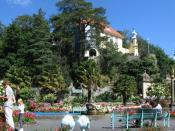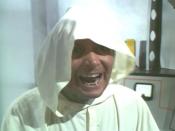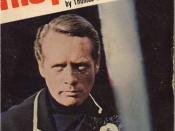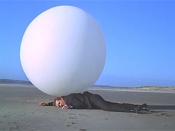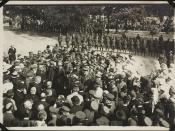Sociology Hidden Fall Out The 1960's science fiction television series, "The Prisoner", dealt with a number of intriguing sociological aspects, in which there are many interpretations to which one the series concerns. Although I believe there is a combination of everything, in my opinion the main focus of the series was to demonstrate society's nature of shunning individuality, and manipulating one's ideas into conformity. The opening scene of the series sets the stage for this idea when The Village tries to assign the prisoner (Patrick McGoohan) a number (No. 6). In response an outraged Mcgoohan cries " I am not a number, I am a free man". Throughout the whole series conformity was tried to be enforced on McGoohan (No. 6), and throughout the series he resisted. The final episode "Fall Out" was no exception.
Fall Out begins after No. 6 prevails in a battle of mental torture with No.2,
in which both men were locked in a room and only one man would walk out alive. When the doors are opened, and No.6 is taken to an underground level of The Village. Here he finds an assembly of villagers who are dressed in cloaks and black and white masks. This assembly represents society who have all conformed to someone else's ideals, and have lost all individuality. This is represented by the way they are all dressed alike. There is also a president who speaks for the assembly. No.6 is greeted by the assembly and the president with a loud applause, and congratulated for his outstanding efforts to resist The Village. When the president demands for the assembly to be silent, he slams his gable and they are quiet instantly. This is another indication of the assembly being a brainwashed society. No.6 is then told that he will be witness to the interrogation of two other men, No.48, and the No.2 that No.6 defeated in the embryo room (brought back to life by The Village). Because all of No.6's potential allies, in previous cases, turned against him in fear of what other members of The Village might think, these men seem to represent the only other individuals in The Village besides No.6. These three men represent the different types of individual rebellion against society. No.48 is a young man who is in rebellion for the sole purpose of rebelling. This rebellion can be compared to that of a teenager who defies authority just because they can. At one point the assembly plays along with his rebellion, singing along in the "Dry Bones" melody. The assembly does so because to them his rebellion poses no threat to their order, and is done for the sole purpose of saving himself. No.2's rebellion was however a little different. No.2 is not just in it for No.2, he is rebelling against the principles of The Village, being enforced upon all of its inmates. This rebellion has to be taken rather seriously, because it poses an indirect threat to the ideals of The Village. No.6's rebellion is feared by The Village. He has taken everything they have thrown at him, and has always prevailed. He poses a direct threat to The Village and its society of accordance. To try and halt this problem before it gets out of control, they make No.6 feel like he had won, and slowly try to integrate him into their society by letting him decide the fait of the other two rebels, and offering him a position of high authority in The Village. He is then granted to speak before the assembly. When he begins to speak, the assembly yells over him, not allowing him to speak. Every time No.6 tries to start a sentence he is interrupted. The only word he manages to say is I. The assembly is depicting society that will not allow the individual to be heard. The only word he is able to muster is "I", a reminder that he still maintains an independent mind. Following this, No.6 demands to meet No.1. He is sent down to an even lower level, where he sees that the other two rebels are being held in clear glass containers. He is then sent up a set of spiral stairs to No.1's room. No.1 is in the back of the room wearing a white cloak and a mask. No.1 represents societies last attempt to incorporate No.6 into their culture of mimicry's. No.1 then hands No.6 a glass orb, No.6 immediately smashes it. This orb represents the idea of conformity being offered to No.6 by society. No.6 rejects this idea thus smashing the orb to pieces. No.6 then reveals No.1, wearing a monkey mask. This represents the society as people in accordance to the phrase "monkey see, monkey do". The monkey mask is then torn away and No.1 has the face of No.6. This shows both the battle of No.6 within himself to resist, and how in this society everyone is the same. No.6 then runs out of No.1's room locking him in. This room turns out to be a rocket ship, and No.1 is blasted into space. The flame from the rocket boosters then burn the white bubble Rover. Rover's destruction symbolizes the death of one of societies enforcers, aimed to crush independent minds. No.6 breaks his fellow rebels out, and escape the island, shooting their way through guards and the assembly. No.6 had finally made it out of "The Village".
In the final episode, many questions were answered, including the most anticipated, who No.1 was. However, there were many left unanswered. The location of The Village was never revealed, the reason No.2 died in the embryo room was kept a secret, the reason No.6 resigned was never told, and perhaps the biggest question of all was left hanging in the balance. When No.6 arrives back in England, the door to his apartment opens automatically like in the village. This leaves you to wonder, did No.6 ever actually escape the village? When you sleep tonight, dreaming of large white balloons rising from the deep and carrying you away from your comforting world, place reassurance in that when you wake, you will return to your delightful convocation, in which we are all prisoners.
